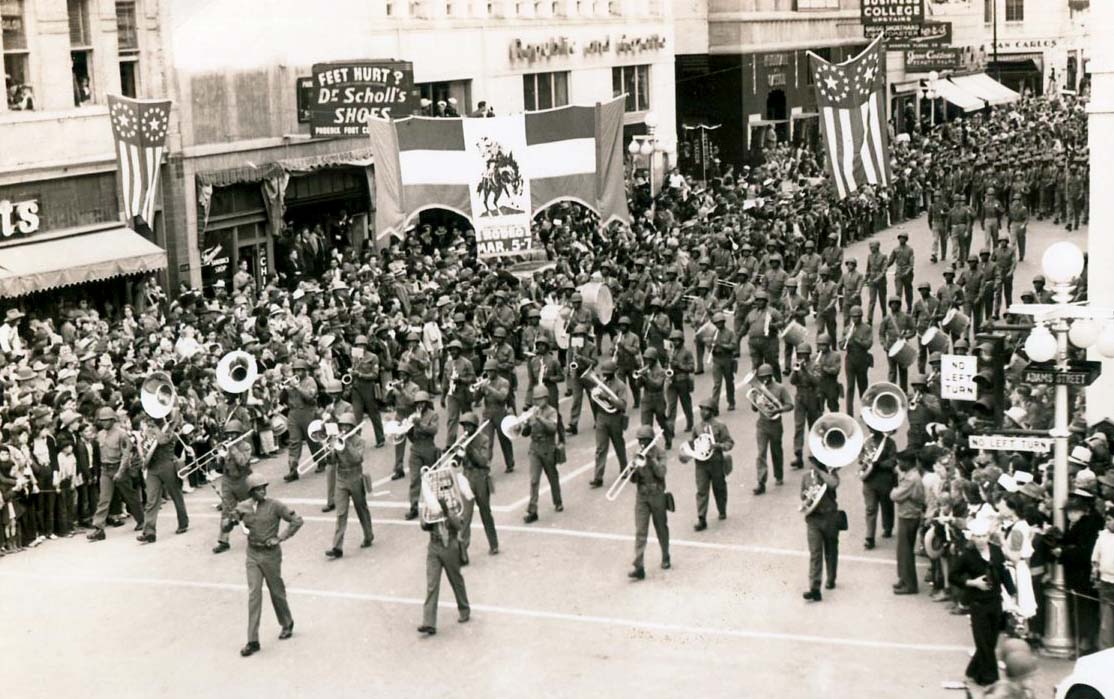In March 1943, the United States Army renamed the 367th Negro Infantry Regiment the 364th Negro Infantry Regiment. Most of the new recruits came from Chicago, Philadelphia, and New York. By June, the regiment, consisting of approximately 3,000 soldiers, was sent to Camp Papago Park in Arizona.
Since the inception of the unit, white officers were put in command and most of them treated the black enlisted men with contempt. When members of the regiment tried to write letters to their Congressmen and Senators complaining of their treatment, the correspondence was intercepted by regiment officers and used against them. Not surprisingly the men of the 364th were labeled “troublemakers.” A grassroots organization known as the Victory at Home and Victory Abroad (Double V) Campaign formed in 1941 to protest racial discrimination both in the military and in civilian life, took up the cause of these soldiers. Some soldiers, in appreciation, branded or carved a Double V on their chests.
After the Phoenix Thanksgiving Riot of 1942, which involved the 364th, the Army retaliated against them by transferring the troops to Camp Van Dorn, Mississippi on May 26, 1943. Despite the transfer, the unit continued to demand equal treatment. At any given time, there were 65 to 85 men imprisoned in a stockade for minor infractions. One young soldier, Francis Johnson of Chester, Pennsylvania, was confined and limited to bread and water for fifteen days because he protested the white commanding officer kicking him. That officer was known to draw his pistol and shoot at the soldiers’ feet to get them to “look lively.”
Private William Walker of the 364th got into a fight with white MPs near the entrance of the base on May 30, 1943, within days of their arrival in Mississippi. The MPs attempted to arrest Walker over a missing button on his uniform. The Wilkerson County sheriff saw the confrontation and shot Private Walker. When the members of the 364th heard of the incident, they broke into the base storerooms, took rifles and ammunition, and prepared to seek revenge. A black MP riot squad was called out. Shots were fired into the crowd, wounding one soldier in the leg.
What happened to the soldiers next remains a mystery. Some soldiers were transferred to other units. Many were shipped off to the Aleutian Islands for security duty. These soldiers repulsed several Japanese Army attacks at Amchitka Island. A rumor claimed over twelve hundred members of the 364th were lined up and shot by white soldiers and civilians. The incident, known as the Camp Van Dorn Slaughter, has been consistently denied by the U.S. Army. Yet between June 1943 and 1945 when the regiment was disbanded, over 800 names had disappeared from the regimental roster.
The absence of any clear evidence of the fate of many of these “missing” soldiers encouraged the massacre story and a 1998 book by former Mississippi banker Carroll Chase called The Slaughter: An American Atrocity eventually prompted television documentaries and investigations by the U.S. Army, the NAACP, and Mississippi Congressman Bennie Thompson. While all found ample evidence of strangely missing records and harsh, even cruel treatment of the soldiers of the 364th, their investigations found no definitive proof of the Camp Van Dorn Slaughter. The fate of the 800 “missing” soldiers of the 364th Regiment, however, remains a mystery today.

